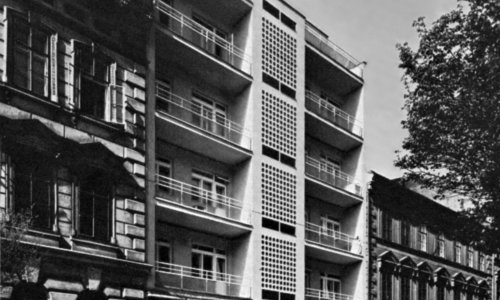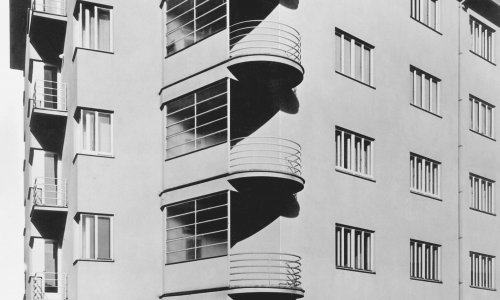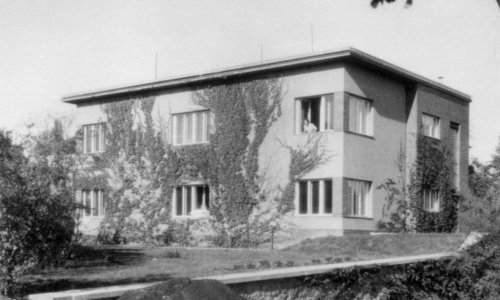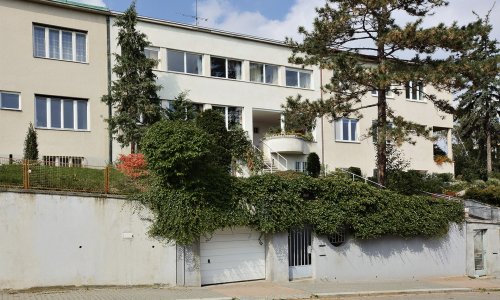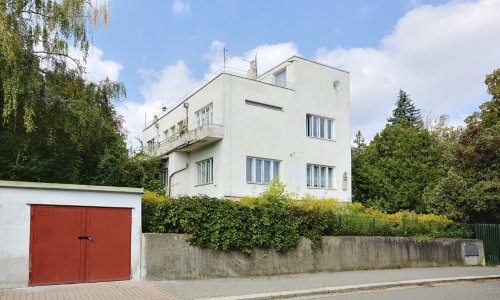Below Špilberk 1918–1945
The area around Špilberk Castle is one of the longest inhabited parts of Brno. Old Brno, situated to the south, is even considered to be the city's oldest territory. A medieval settlement is believed to have grown close to the Svratka River as early as the 10th century. However, the heart of the city later moved to the hill of present-day Petrov, around which Brno formed from the 13th century onwards. Špilberk Castle was built at the same time as the city fortifications and Old Brno thus became a mere suburb. However, as Old Brno was situated on an important southward trading route, it flourished and received the status of township in the 16th century.
The founding of the monastery (in present-day Mendlovo náměstí), which became the heart of Old Brno, played a crucial role in the town's future development. However, the presence of the Svratka millrace flowing in from the west along present-day Výstavní Street was no less important. The oldest residential buildings as well as later industrial facilities (the Old Brno brewery) grew on the banks of the millrace. The millrace ran through the very centre of the present transport node of Mendlovo náměstí and flowed eastwards across the yards of two other convents and and a hospital (today's St. Ann's Hospital). In 1850, Old Brno became part of Brno and covered a vast area on both banks of the Svratka River and areas lining important roads such as present-day Výstavní, Křížová, Hybešova, Pekařská streets and gradually developing Úvoz Street.
North of Špilberk was a territory known as "Švábka" according to its first inhabitants. This area was situated along present-day Údolní Street and formed one of the city's medieval outskirts, but was much smaller than Old Brno. The residential buildings involved mainly farmers', craftsmen's and traders' houses. The slopes of Špilberk covered with gardens and vineyards merged in Žlutý Hill, whose clay was used by several brickworks.
Švábka underwent a considerable transformation in the late 19th century, when it was incorporated into Brno along withother outlying areas. After the city's bulwarks were demolished, the southern part of Švábka became part of the municipal ring road, the Ringstrasse. In this way, it was linked to the newly built avenues, present-day Husova and Joštova streets. The predominant apartment buildings constructed on both sides of Údolní Street and the newly built Obilní trh náměstí became the heart of a new and extensive residential estate. The street itself was an important link between the centre and new residential areas on Žlutý and Kraví hills. Once linked to Úvoz, Švábka, together with Pekařská Street, became a main transport artery leading to Old Brno.
A new street network was created on the slopes of Žlutý Hill near the junction of Údolní and Úvoz streets before World War I. However, the actual building did not begin until the 1920s, when, after Brno's expansion and the incorporation of surrounding villages in 1919, the soaring population caused demand for housing to grow. The area witnessed the building of primarily apartment buildings (in present-day Údolní, Úvoz, Gorkého and Grohova streets); however, several villas were also built in this attractive location overlooking Old Brno (the surroundings of present-day Tomešova Street) and merged into the spreading residential development of the Masaryk Quarter.
The location on Žlutý Hill was also chosen for buildings for the newly founded Masaryk University. Established in 1919, the university sought suitable locations for its faculties. While it chose Žlutý Hill as the seat of the Faculty of Medicine, the remaining Faculty of Law, Faculty of Arts and Faculty of Sciences were intended to form the so-called Academic Quarter on the foot of Kraví Hill. However, this plan never came to fruition and the Faculty of Medicine only received two facilities in the extensive area of the former military base stretching between Údolní, Tvrdého and Úvoz streets.
The building of the nearby exhibition centre in 1928 had a major influence on the interwar character of Old Brno. U Plovárny Street (present-day Výstavní Street) led from the exhibition centre past the newly extended municipal spa complex in Rybářská Street (present-day Veletržní street) as far as the brewery. It ran into Mendlovo náměstí at the site of the present tramway loop outside the monastery. In 1930 a new apartment building was added to the originally compact residential development spreading on both banks of the Svratka millrace near the Old Brno town hall, which has been preserved until the present as a reminder of this former picturesque part of Old Brno.
Once society had overcome the aftermath of the global economic crisis, the demand for apartment buildings rocketed in the late 1930s. Striving to provide a sufficient number of flats for the middle and lower classes, private investors or building companies erected apartment buildings as well as entire street blocks along both routes linking Old Brno with the city's historic centre. The surroundings of Úvoz Street witnessed intensive building mainly in Údolní, Gorkého, Čápkova and Grohova streets. Apartment buildings supplemented the historic buildings in Pekařská and Pellicova streets on the other side of Špilberk Hill.
The area around Špilberk Castle has been affected by historical war events as well as modern urbanism interventions. The area of the military base was demolished for the purpose of redevelopment in relation to the adaptation of the New Town Hall in Husova Street in the 1930s. The originally planned Official Building of the City of Brno was not built in the end, though. The free plot and its surroundings were hit several times during the Allied forces' air raids at the end of World War II. The International Hotel was built on a part of the free area in the 1960s; the rest is still empty. A large portion of the southern part of Obilní trh náměstí was also destroyed in the bombing, and the area has never received an architecturally suitable reconstruction.
However, the latest development has left the most pronounced marks on the character of Mendlovo náměstí. Several bombs destroyed the city spa and some of the buildings along the millrace in the very heart of Old Brno. František Kočí created a new urban concept in 1962 - 65 in response to a request to build a spectacular avenue leading to the gates of the bustling exhibition centre. Filling the Svratka millrace, extending the broad transport artery of Veletržní Street, redeveloping the historic buildings in the centre of the square and implementing architectural plans only partially resulted in a fatal loss of the genius loci. Despite several recent attempts at finding a suitable architectural design for Mendlovo náměstí, this location remains an unsightly transport junction.
Name
Below Špilberk 1918–1945
Length
4,5 KM
Number of objects
34
Trail Starts Here
Dominikánské náměstí 196
First object
New Town Hall reconstruction
C124
Public transport
Šilingrovo náměstí (TRAM 4, 12)
Šilingrovo náměstí (TRAM 5, 6)
GPS
Download as GPX file
Download as KML file
































